Numerical Investigation of Low-Velocity Ice Impact on a Composite Ship Hull Using an FEM/SPH Formulation
Abstract
:1. Introduction
1.1. General Context
1.2. Research Novelty
1.3. Ice Interaction
- Ice properties: The type and characteristics of the ice significantly impact the interaction. Factors such as ice thickness, ice concentration, ice strength, and ice temperature affect how the ice interacts with the ship;
- Ship design: The design of the ship’s hull and ice-breaking capabilities play a crucial role in determining how the vessel interacts with the ice;
- Ship speed and operation: The speed at which the ship moves through the ice affects the magnitude of ice loads and the resulting interaction;
- Environmental conditions: The environmental conditions, including air temperature, water temperature, wind speed, and ice drift, can influence the ice–ship interaction.
1.4. Using Numerical Methods
- Large deformations: Ice can undergo substantial deformations under load, which can result in nonlinear behaviour. FEM typically relies on linear or moderately nonlinear assumptions, making it less suitable for accurately capturing the highly nonlinear response of ice under large deformations;
- Fracture and failure: Ice is prone to fracturing and failure when subjected to high stress concentrations or sudden impacts. Modelling these fracture mechanisms within the FEM framework can be challenging, as it requires accurately representing the crack initiation, propagation, and interaction;
- Fragmentation: Ice can fragment into smaller pieces during impact events, creating a complex system of multiple interacting bodies. Modelling this fragmentation process with FEM would require intricate meshing and tracking of individual ice fragments, which can be computationally demanding and impractical.
- 5.
- 6.
- 7.
- Smoothed particle hydrodynamics (SPH): This is a meshless method, representing materials as particles. Initially developed as a probabilistic meshfree particle method for simulating astrophysical problems [34], SPH is well suited for simulating fluid behaviour and can accurately capture large deformations, fractures, and fragmentation without the need for complex meshing, as some research demonstrates [20,35,36,37,38,39,40].
2. Materials and Methods
2.1. Ice Model Assessment
2.2. Geometry and Discretized Model
2.3. Material Model
3. Results and Discussion
4. Conclusions
Author Contributions
Funding
Institutional Review Board Statement
Informed Consent Statement
Data Availability Statement
Conflicts of Interest
References
- Chandrasekaran, S. Ice Forces on Structures; Woodhead Publishing: Cambridge, UK, 2015; ISBN 978-0-08-100655-4. [Google Scholar]
- Jordaan, I.J.; Shepherd, I. Ship-Ice Interaction. In Encyclopedia of Ocean Sciences, 3rd ed.; Elsevier: Amsterdam, The Netherlands, 2009; pp. 611–620. [Google Scholar]
- Trochim, E.D. Ice Loads on Ships and Structures. In Encyclopedia of Hydrodynamics; National Research Council Canada: Ottawa, ON, Canada, 2008; pp. 1–12. [Google Scholar]
- Timco, G.W.; Frederking, R.M. Introduction to Ice Navigation and Ice Mechanics. In Practical Ice Navigation; Springer: Dordrecht, The Netherlands, 2013; pp. 1–19. ISBN 978-94-007-5773-3. [Google Scholar]
- Su, B.; Riska, K.; Moan, T. Numerical study of ice-induced loads on ship hulls. Mar. Struct. 2011, 24, 132–152. [Google Scholar] [CrossRef]
- Deggim, H. The international code for ships operating in polar waters (Polar Code). In Sustainable Shipping in a Changing Arctic; Springer: Berlin/Heidelberg, Germany, 2018; pp. 15–35. [Google Scholar]
- Timco, G.W.; Weeks, W.F. Ice Forces on Structures. In Sea Ice: An Introduction to Its Physics, Chemistry, Biology, and Geology; Wiley-Blackwell: Hoboken, NJ, USA, 2010; pp. 385–421. ISBN 978-1-4051-9632-0. [Google Scholar]
- Li, C.; Ehlers, S. Numerical Simulation of Ice-Induced Loads on Ships. Cold Reg. Sci. Technol. 2013, 96, 1–16. [Google Scholar] [CrossRef]
- Khedmati, M.R.; Jordaan, I.J. Analysis of Ice Forces on a Ship Using a Coupled Finite Element Model. Ocean. Eng. 2012, 49, 21–29. [Google Scholar] [CrossRef]
- Arntsen, A.; Jordaan, I.J. Ice-Induced Structural Loading on a Ship Hull-Comparison Between Model Tests and Numerical Analysis. Cold Reg. Sci. Technol. 2003, 37, 377–397. [Google Scholar]
- Brinkmann, P.; Lindqvist, P.A.; Elfving, A. A Numerical Analysis of Ice Loads on Ships Using a Simplified Ice-Ship Interaction Model. Cold Reg. Sci. Technol. 2012, 71, 91–100. [Google Scholar] [CrossRef]
- Frederking, R.M.; Jordaan, I.J. Numerical Analysis of Ice Forces on a Ship Hull. Cold Reg. Sci. Technol. 2002, 35, 67–85. [Google Scholar]
- Zhang, M.; Cheemakurthy, H.; Ehlers, S.; Polach, R.U.F.v.B.U.; Garme, K.; Burman, M. Ice pressure prediction based on the probabilistic method for ice-going vessels in inland waterways. In Proceedings of the ASME 2018 37th International Conference on Ocean, Offshore and Arctic Engineering, Madrid, Spain, 17–22 June 2018; Volume 8. [Google Scholar] [CrossRef]
- Matala, R. Investigation of model-scale brash ice properties. Ocean Eng. 2021, 225, 108539. [Google Scholar] [CrossRef]
- Lubbad, R.; Løset, S. A numerical model for real-time simulation of ship–ice interaction. Cold Reg. Sci. Technol. 2011, 65, 111–127. [Google Scholar] [CrossRef]
- Erceg, B.; Ralph, F.; Ehlers, S.; Jordaan, I. Structural Response of Ice-Going Ships Using a Probabilistic Design Load Method. In Proceedings of the ASME 2015 34th International Conference on Ocean, Offshore and Arctic Engineering, St. John’s, NL, Canada, 31 May–5 June 2015. [Google Scholar] [CrossRef]
- Daley, C.G.; Riska, K. Review of Ship-Ice Interaction Mechanics Report from Finnish-Canadian Joint Research Project No. 5 ‘Ship Interaction with Actual Ice Conditions’ Interim Report on Task 1A; Helsinki University of Technology: Espoo, Finland, 1990. [Google Scholar] [CrossRef]
- Rubino, F.; Nisticò, A.; Tucci, F.; Carlone, P. Marine application of fiber reinforced composites: A review. J. Mar. Sci. Eng. 2020, 8, 26. [Google Scholar] [CrossRef]
- Chalmers, D. Experience in design and production of FRP marine structures. Mar. Struct. 1991, 4, 93–115. [Google Scholar] [CrossRef]
- Zhang, Z.; Li, C.; Ehlers, S. Numerical Simulation of Ice-Structure Interaction Using Smoothed Particle Hydrodynamics. Ocean. Eng. 2015, 107, 1–12. [Google Scholar] [CrossRef]
- Vaziri, R.; Dalvand, M.; Mousavizadegan, S.H. A Smoothed Particle Hydrodynamics Model for Analysis of Ice Impact on Ship Structures. Cold Reg. Sci. Technol. 2014, 108, 52–63. [Google Scholar] [CrossRef]
- Khedmati, M.R.; Jordaan, I.J. Application of Smoothed Particle Hydrodynamics to Simulate Ice-Structure Interaction. Cold Reg. Sci. Technol. 2015, 118, 111–121. [Google Scholar] [CrossRef]
- Grabe, J.; Gjevik, B. Smoothed Particle Hydrodynamics Modelling of Ice-Structure Interaction. Cold Reg. Sci. Technol. 2013, 92, 24–33. [Google Scholar] [CrossRef]
- Kendrick, A.M. Polar Ship Design Standards–State of the Art, and Way Forward. Transactions 2014, 122, 428–433. [Google Scholar]
- Adams, J.M. Application of an Extended Inverse Method for the Determination of Ice-Induced Loads on Ships. Master’s thesis, Aalto University, Espoo, Finland, 2018. [Google Scholar]
- Kõrgesaar, M.; Kujala, P. Validation of the Preliminary Assessment Regarding the Operational Restrictions of Ships Ice-Strengthened in Accordance with the Finnish-Swedish Ice Classes When Sailing in Ice Conditions in Polar Waters; Aalto University: Espoo, Finland, 2017. [Google Scholar]
- Dudal, A.; Besse, P.; Yakimov, V.V.; Tryaskin, V.N. Numerical Tool for Basic Design Appraisal of Ice-Going Vessels. In Proceedings of the 109th Session of the Association Technique Maritime et Aéronautique—ATMA 2011, Paris, France, 23–24 May 2011. Bulletin de l’Association Technique Maritime et Aéronautique. [Google Scholar]
- Vermel, V.; Poulimenakos, K.; Cambos, P. A Method for Hull Scantlings Calculations for Ships Sailing in Low Salinity Waters. In Proceedings of the International Conference on Port and Ocean Engineering under Arctic Conditions, Trondheim, Norway, 14–18 June 2015. [Google Scholar]
- Bureau Veritas—Additional Class Notation Polar Class—Rules for the Classification of Polar Class Ships—February 2021. Available online: https://erules.veristar.com/dy/data/bv/pdf/527-NR_2021-01.pdf (accessed on 20 August 2024).
- Dorsk, A. Numerical Simulation of Sea Ice Dynamics with the Discrete Element Method; Internal report; Franklin W. Olin College of Engineering: Needham, MA, USA, 2006. [Google Scholar]
- Ji, S. Discrete element modelling of ice loads on ship and offshore structures. In Proceedings of the 7th International Conference on Discrete Element Methods; Springer: Singapore, 2017; pp. 45–54. [Google Scholar]
- Lu, W.; Li, M.; Vazic, B.; Oterkus, S.; Oterkus, E.; Wang, Q. Peridynamic modelling of fracture in polycrystalline ice. J. Mech. 2020, 36, 223–234. [Google Scholar] [CrossRef]
- Zhang, Y.; Tao, L.; Wang, C.; Sun, S. Peridynamic analysis of ice fragmentation under explosive loading on varied fracture toughness of ice with fully coupled thermos mechanics. J. Fluids Struct. 2022, 112, 103594. [Google Scholar] [CrossRef]
- Gingold, R.A.; Monaghan, J.J. Smoothed particle hydrodynamics: Theory and application to non-spherical stars. Mon. Not. R. Astron. Soc. 1977, 181, 375–389. [Google Scholar] [CrossRef]
- Zhang, N.; Zheng, X.; Ma, Q.; Hu, Z. A numerical study on ice failure process and ice-ship interactions by Smoothed Particle Hydrodynamics. Int. J. Nav. Arch. Ocean Eng. 2019, 11, 796–808. [Google Scholar] [CrossRef]
- Zhang, N.; Zheng, X.; Ma, Q. Updated smoothed particle hydrodynamics for simulating bending and compression failure progress of ice. Water 2017, 9, 882. [Google Scholar] [CrossRef]
- Pan, W.; Tartakovsky, A.; Monaghan, J. Smoothed particle hydrodynamics non-Newtonian model for ice-sheet and ice-shelf dynamics. J. Comput. Phys. 2013, 242, 828–842. [Google Scholar] [CrossRef]
- Crespo, A.J.C. Application of the Smoothed Particle Hydrodynamics Model SPH Physics to Free-Surface Hydrodynamics. Ph.D. Thesis, Departamento De Fisica Aplicada, Universidade De Vigo, Vigo, Spain, 2008. [Google Scholar]
- Fragassa, C.; Topalovic, M.; Pavlovic, A.; Vulovic, S. Dealing with the effect of air in fluid structure interaction by coupled SPH-FEM methods. Materials 2019, 12, 1162. [Google Scholar] [CrossRef] [PubMed]
- Pavlović, A.; Minak, G. FEM-SPH Numerical Simulation of Impact Loading on Floating Laminates. J. Mar. Sci. Eng. 2023, 11, 1590. [Google Scholar] [CrossRef]
- Gagnon, R. A numerical model of ice crushing using a foam analogue. Cold Reg. Sci. Technol. 2011, 65, 335–350. [Google Scholar] [CrossRef]
- Kim, H. Simulation of compressive ‘cone-shaped’ ice specimen experiments using LS-DYNA. In Proceedings of the 13th International LS-DYNA Users Conference, Dearborn, MI, USA, 8–10 June 2014. [Google Scholar]
- Zhang, A.; Yang, W.; Huang, C.; Ming, F. Numerical simulation of column charge underwater explosion based on SPH and BEM combination. Comput. Fluids 2013, 71, 169–178. [Google Scholar] [CrossRef]
- Zhang, Z.; Qiang, H.; Fu, X.; Xia, W. A 7.62 mm Rifle Bullet Impacting on a 30CrMnSiA Steel Target Plate: SPH-FEM Conversion Algorithm. Chin. J. Comput. Phys. 2012, 29, 73–81. [Google Scholar]
- Zhang, Z.; Qiang, H.; Gao, W. Conversion of 3D Distorted Finite Elements into SPH Particles During Impact Dynamic Deformation. J. Xi’an Jiaotong Univ. 2011, 45, 105–110. [Google Scholar]
- McCarthy, M.A.; Xiao, J.R.; McCarthy, C.T.; Kamoulakos, A.; Ramos, J.; Gallard, J.P.; Melito, V. Modelling of bird strike on an aircraft wing leading edge made from fibre metal laminates—Part 2: Modelling of impact with SPH bird model. Appl. Compos. Mater. 2004, 11, 317–340. [Google Scholar] [CrossRef]
- Zhou, Y.; Sun, Y.; Huang, T. SPH-FEM design of laminated plies under bird-strike impact. Aerospace 2019, 6, 112. [Google Scholar] [CrossRef]
- Zhou, Y.; Sun, Y.; Huang, T.; Cai, W. SPH-FEM simulation of impacted composite laminates with different layups. Aerosp. Sci. Technol. 2019, 95, 105469. [Google Scholar] [CrossRef]
- Ni, B.-Y.; Han, D.-F.; Di, S.-C.; Xue, Y.-Z. On the development of ice-water-structure interaction. J. Hydrodyn. 2020, 32, 629–652. [Google Scholar] [CrossRef]
- Jeon, S.; Kim, Y. Numerical simulation of level ice–structure interaction using damage-based erosion model. Ocean Eng. 2021, 220, 108485. [Google Scholar] [CrossRef]
- Chen, Z.; He, Y.; Gu, Y.; Su, B.; Ren, Y.; Liu, Y. A novel method for numerical simulation of the interaction between level ice and marine structures. J. Mar. Sci. Technol. 2021, 26, 1170–1183. [Google Scholar] [CrossRef]
- Banik, A.; Zhang, C.; Khan, M.H.; Wilson, M.; Tan, K.T. Low-velocity ice impact response and damage phenomena on steel and CFRP sandwich composite. Int. J. Impact Eng. 2022, 162, 104134. [Google Scholar] [CrossRef]
- Olsson, R. Mass criterion for wave controlled impact response of composite plates. Compos. Part A Appl. Sci. Manuf. 2000, 31, 879–887. [Google Scholar] [CrossRef]
- Pavlovic, A.; Fragassa, C. Numerical modelling of ballistic impacts on flexible protection curtains used as safety protection in woodworking. Proc. Inst. Mech. Eng. Part C J. Mech. Eng. Sci. 2017, 231, 44–58. [Google Scholar] [CrossRef]
- Pavlovic, A.; Fragassa, C. Analysis of flexible barriers used as safety protection in woodworking. Int. J. Qual. Res. 2016, 10, 71–88. [Google Scholar]
- Riska, K.; Uto, S.; Tuhkuri, J. Pressure distribution and response of multiplate panels under ice loading. Cold Reg. Sci. Technol. 2002, 34, 209–225. [Google Scholar] [CrossRef]
- Di Caprio, F.; Cristillo, D.; Saputo, S.; Guida, M.; Riccio, A. Crashworthiness of wing leading edges under bird impact event. Compos. Struct. 2019, 216, 39–52. [Google Scholar] [CrossRef]
- LS-DYNA Keyword User Manual Version 971; Livermore Software Technology Corporation: Livermore, CA, USA, 2007; Volume I.
- Song, Z.; Le, J.; Whisler, D.; Kim, H. Skin-stringer interface failure investigation of stringer-stiffened curved composite panels under hail ice impact. Int. J. Impact Eng. 2018, 122, 439–450. [Google Scholar] [CrossRef]
- Feraboli, P.; Wade, B.; Deleo, F.; Rassaian, M.; Higgins, M.; Byar, A. LS-DYNA MAT54 modeling of the axial crushing of a composite tape sinusoidal specimen. Compos. Part A Appl. Sci. Manuf. 2011, 42, 1809–1825. [Google Scholar] [CrossRef]
- Chen, X.; Sun, X.; Chen, P.; Wang, B.; Gu, J.; Wang, W.; Chai, Y.; Zhao, Y. Rationalized improvement of Tsai–Wu failure criterion considering different failure modes of composite materials. Compos. Struct. 2020, 256, 113120. [Google Scholar] [CrossRef]
- Feng, D.; Aymerich, F. Finite element modelling of damage induced by low-velocity impact on composite laminates. Compos. Struct. 2014, 108, 161–171. [Google Scholar] [CrossRef]
- Sutherland, L.S.; Soares, C.G. The use of quasi-static testing to obtain the low-velocity impact damage resistance of marine GRP laminates. Compos. Part B Eng. 2012, 43, 1459–1467. [Google Scholar] [CrossRef]
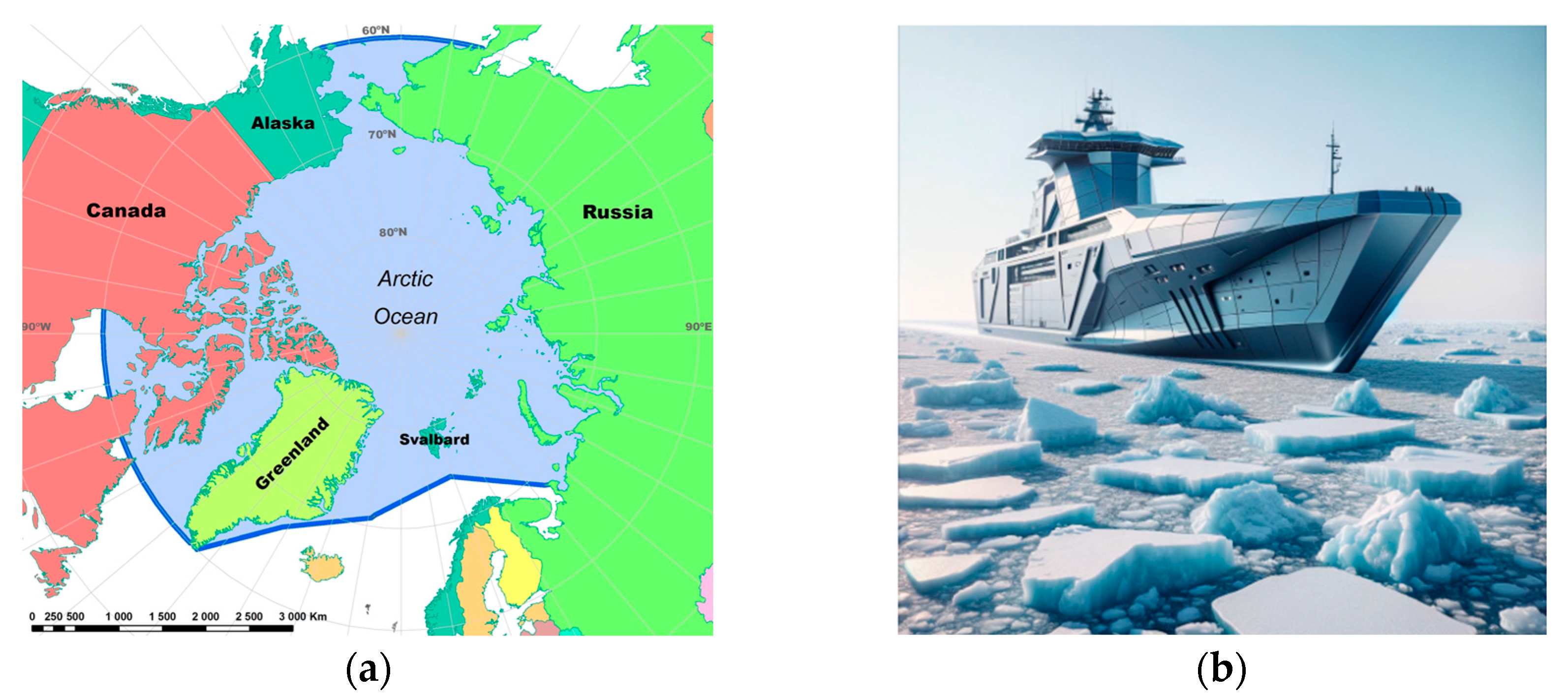




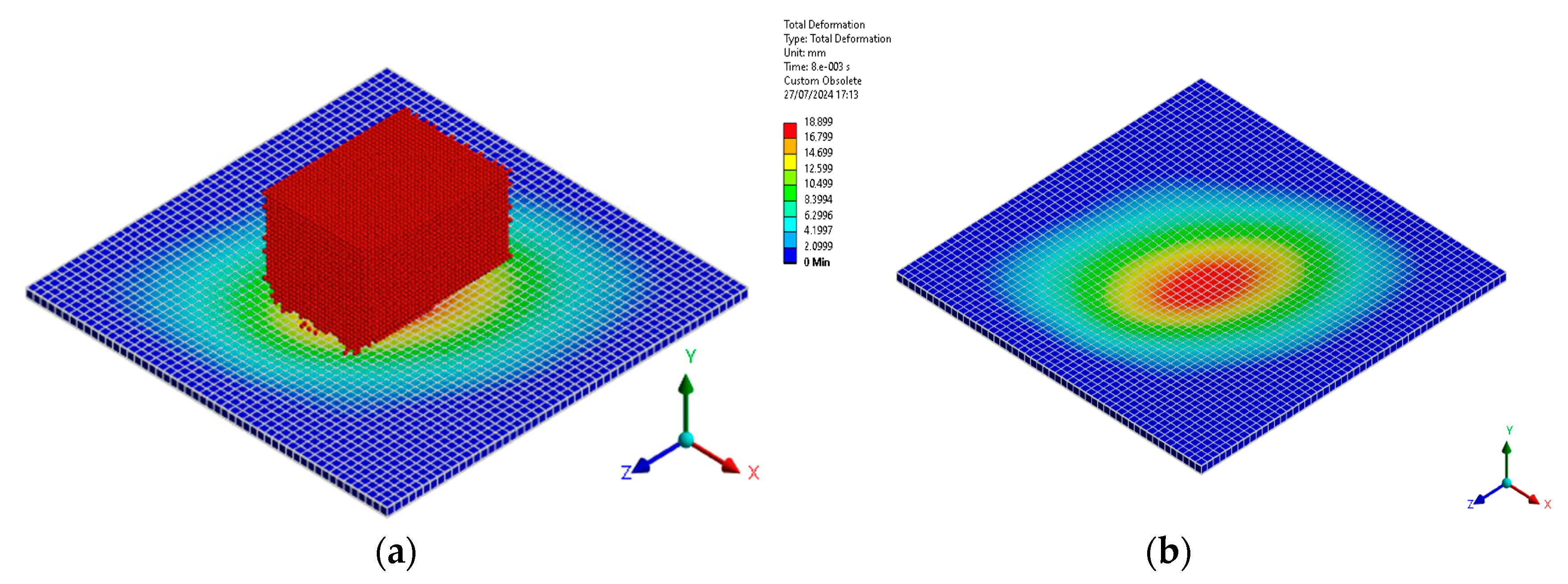



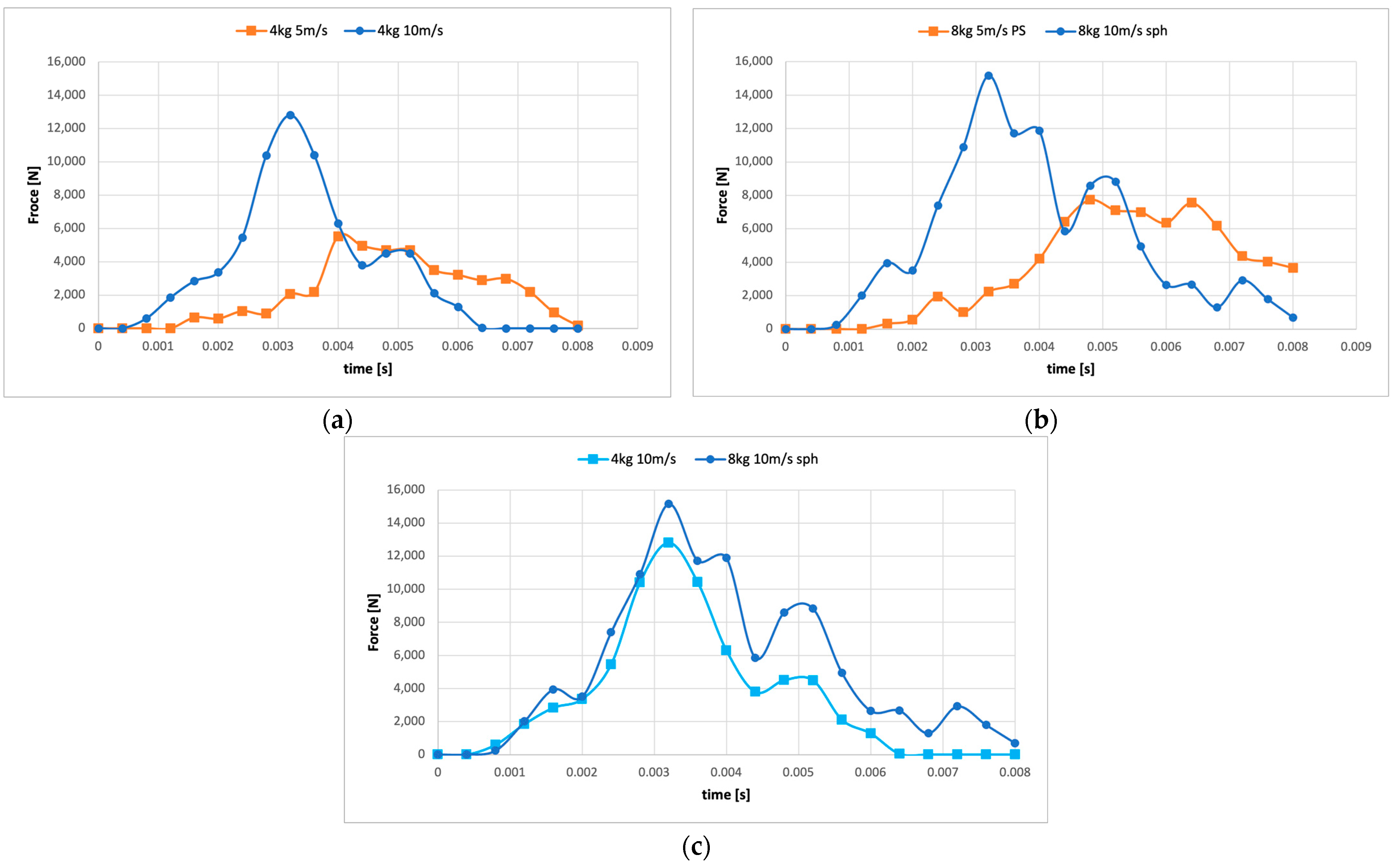

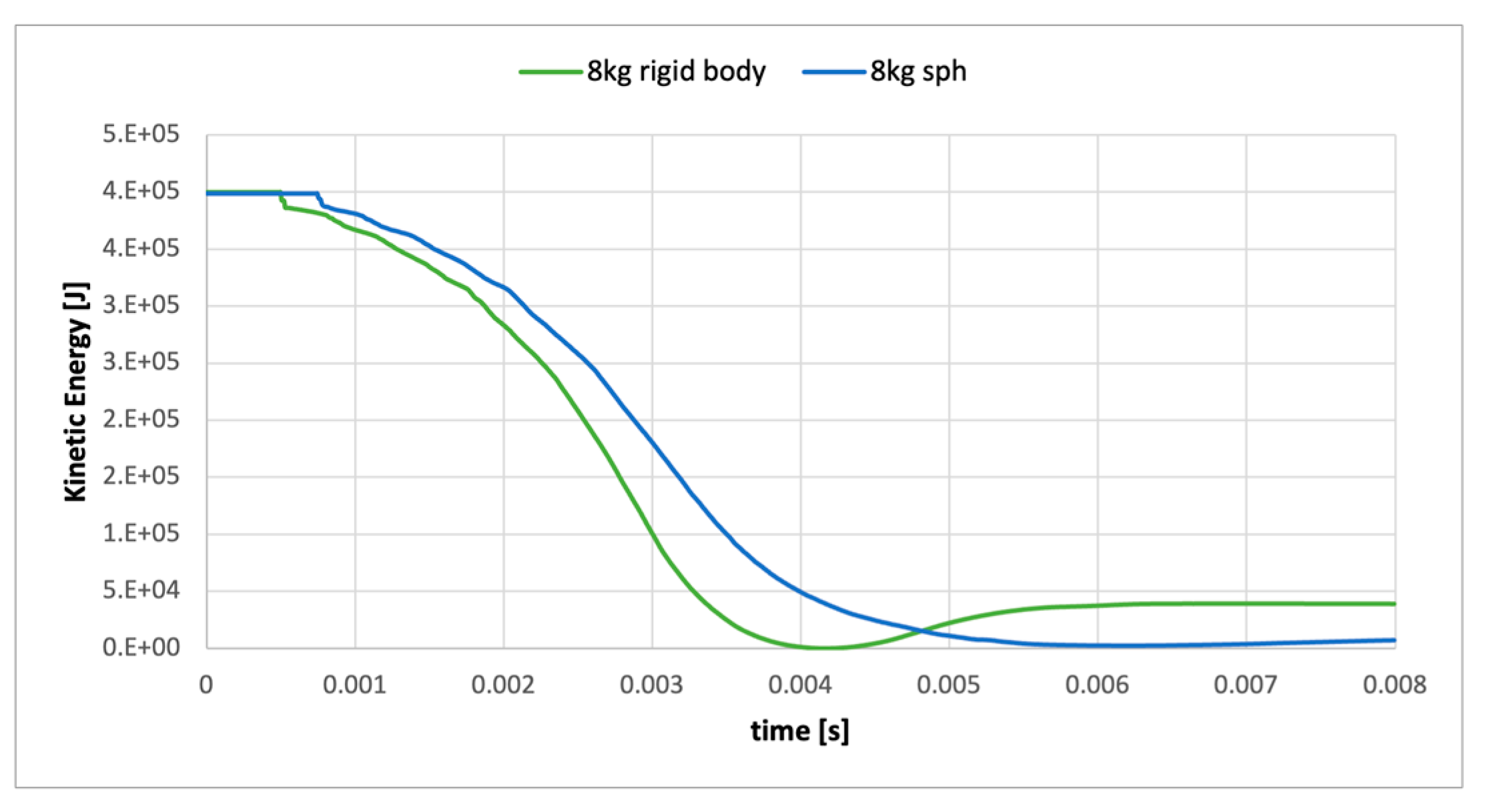
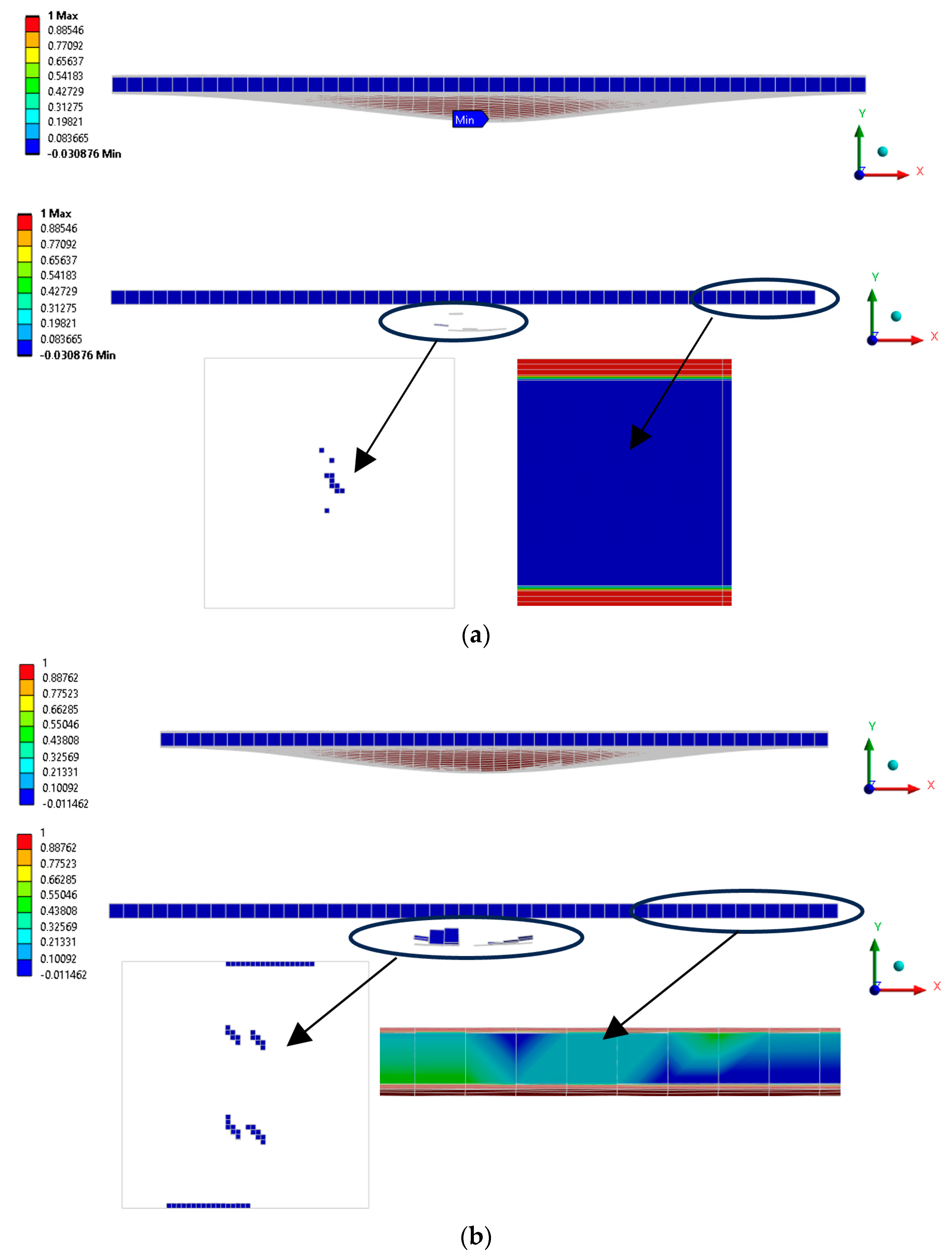
| Property | Symbol | LS-DYNA Parameter | Experimental Value |
|---|---|---|---|
| Density | RO | 1.52 kg/m2 | |
| Young modulus (parallel to fibers) | E1 | EA | 127 GPa |
| Young modulus (transverse to fibers) | E2 | EB/EC | 8.41 GPa |
| Shear modulus | G12 | GAB | 4.21 GPa |
| Major Poisson’s ratio | / | 0.31 | |
| Minor Poisson’s ratio | PRBA | 0.02 | |
| Strength in 1-direction, tension | XT | 2.20 GPa | |
| Strength in 1-direction, compression | XC | 1.47 GPa | |
| Strength in 2-direction, tension | YT | 48.9 MPa | |
| Strength in 2-direction, compression | YC | 199 MPa | |
| Shear strength | SC | 154 MPa |
| Density | Young Modulus | Shear Modulus | Poisson Ratio | Tensile Ultimate Stress | Compressive Ultimate Stress | Shear Strength |
|---|---|---|---|---|---|---|
| 250 kg m−3 | 0.241 GPa | 0.105 GPa | 0.14 | 7.4 MPa | 6 MPa | 4.1 MPa |
Disclaimer/Publisher’s Note: The statements, opinions and data contained in all publications are solely those of the individual author(s) and contributor(s) and not of MDPI and/or the editor(s). MDPI and/or the editor(s) disclaim responsibility for any injury to people or property resulting from any ideas, methods, instructions or products referred to in the content. |
© 2024 by the authors. Licensee MDPI, Basel, Switzerland. This article is an open access article distributed under the terms and conditions of the Creative Commons Attribution (CC BY) license (https://creativecommons.org/licenses/by/4.0/).
Share and Cite
Pavlovic, A.; Minak, G. Numerical Investigation of Low-Velocity Ice Impact on a Composite Ship Hull Using an FEM/SPH Formulation. Appl. Sci. 2024, 14, 7679. https://doi.org/10.3390/app14177679
Pavlovic A, Minak G. Numerical Investigation of Low-Velocity Ice Impact on a Composite Ship Hull Using an FEM/SPH Formulation. Applied Sciences. 2024; 14(17):7679. https://doi.org/10.3390/app14177679
Chicago/Turabian StylePavlovic, Ana, and Giangiacomo Minak. 2024. "Numerical Investigation of Low-Velocity Ice Impact on a Composite Ship Hull Using an FEM/SPH Formulation" Applied Sciences 14, no. 17: 7679. https://doi.org/10.3390/app14177679







